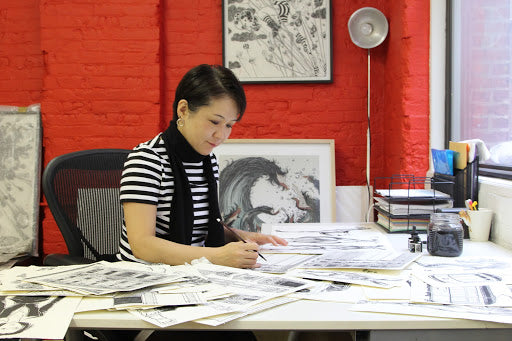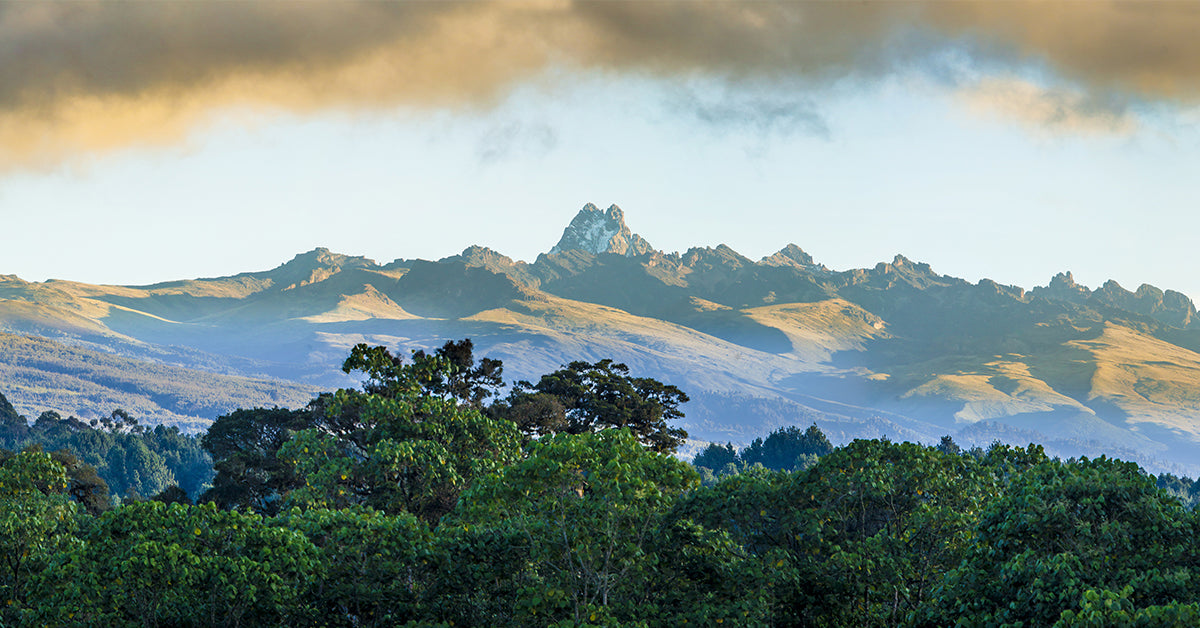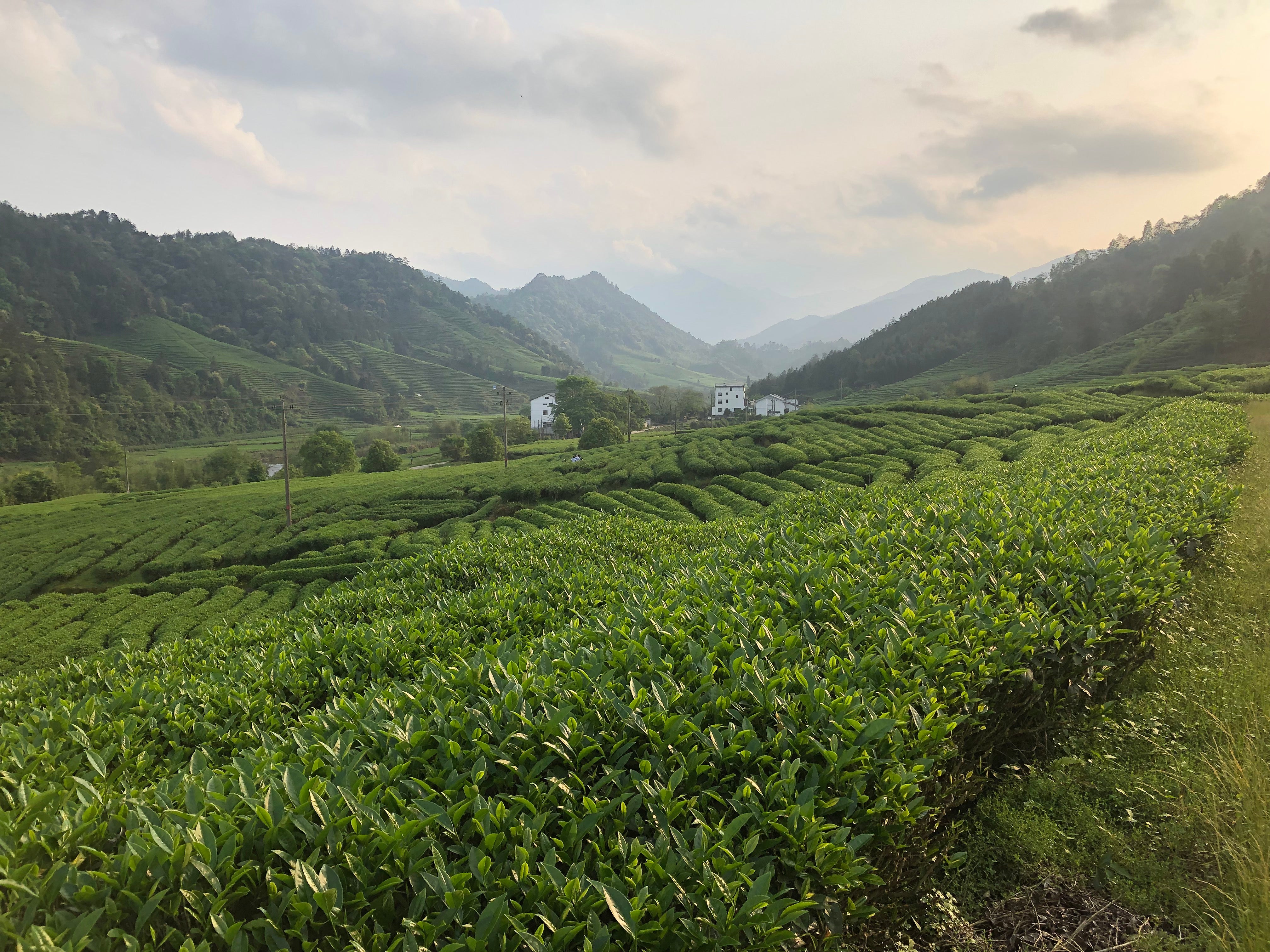
After experiencing her mid-life crisis at the age of 22, Yuko found the courage to leave behind a career in her native Japan, move to New York City and follow her passion to study art; the world would like to say thank you. Yuko’s inspired and distinctive illustrations have graced national magazines, been featured in books, on the covers of DC Comics, the front of Gap t-shirts and so much more. Newsweek Japan chose Yuko as one of “100 Japanese People the World Respects.” We’re pretty sure it’s because she’s a tea drinker, but her immense talent and influence probably have more to do with it.
Learn more about Yuko’s fascinating life, where she finds her inspiration and why tea is an indispensable part of her daily life.

Harney: Tell us a little about you. Where are you from, what’s your educational background?
Yuko: Well, I am a Japanese illustrator living and working in New York City. I initially studied business at a university in Tokyo and worked in corporate PR for quite a while before quitting to move to New York to pursue my dream of being an artist. I went back to school to study art in my mid-30s at the School of Visual Arts in NYC. I graduated and started working as a freelance illustrator in 2003.
Harney: When did you know you wanted to be an artist? Is that what you’ve always done?
Yuko: I guess I’ve always wanted to become an artist. I can’t even recall when I started drawing. When I realized, I was already doing it. I had no doubt. Then again, my very traditional parents didn’t want me to go to art school. I was 17-18 years old, and I didn’t have a strong goal set for my life, so I ended up studying what felt like the most creative of the practical field-- studying advertising and marketing as a business major.
I started my art career in mid-life. Initially, I felt inferior surrounded by my art school classmates who were half my age. But by the time I restarted my new career, I realized nothing I have ever experienced has been a waste of time. I was always probably the most motivated student in my art school classes, making a conscious decision to study after a long detour. After I started working in illustration, I realized half of my job is to run my ‘small business,’ and everything I learned in 11 years of corporate career is indispensable knowledge.
Looking back, if I had a choice to do my life over again, I wouldn’t change a thing. I have been working for 16-17 years or so now, and it would not have been possible without taking a long time to get here, learning about life one detour at a time.

Harney: How do you describe your art, and where do you find the inspiration for your work?
Yuko: At this point in my life, I feel I am neither really Japanese nor American. And my work probably feels the same. So, I guess I am very true in my work with who I am as a real person.
In the beginning, in art school and just in the early part of my career, inspirations came from peers and what’s happening in illustration and visual arts. But as both I and my work mature, I started getting inspirations elsewhere, more so outside of visual arts than inside.
Right now I am in Germany teaching illustration students in design school for a week-long workshop. I get to interact with young people and professors, and I get a lot from them. Of course, I am here to teach, but I also learn a lot. Just by putting myself in an unusual environment, everything I see and feel and hear and eat is also very stimulating. Keeping your senses open to new experiences is the key to get things fresh. I may or may not have time to visit museums with famous paintings, but that doesn’t matter; inspirations are in everything.
Often, I get stuck in my studio in NYC for long hours each day finishing up deadlines. Sometimes I don’t go do fun things or meet up with friends for a long stretch of time. In situations like that, at least I read books on the subway to commute to and from my studio, intentionally picking topics that I am not familiar with. It’s like traveling on a shoestring budget and with time limitations. I get just as bombarded with new stimulation and information. Inspirations are everywhere.
Harney: You’ve done work for some of the biggest names on the planet: Apple, Microsoft, Adobe, Target, The Gap Product Red line, Pepsi, Nike, TIME, The New York Times, The New Yorker, Rolling Stone, GQ, the Library of Congress, National Public Radio, Penguin, Scholastic, DC Comics and so much more. What kind of work do you most enjoy? What has been a favorite project?
Yuko: Working freelance, of course, comes with pros and cons. I may work in unpredictable schedules, sometimes bombarded with work, other times not. The good thing about it, though, is that every project is different. Each also comes with pros and cons, and I enjoy every experience as they are.
Having said that, I feel the most successful projects happen when clients fully trust the artists they hire and consider that choosing the right artist for the right project is their most important job. When these clients come, they give us a lot of flexibility to express our freedom to think of ideas and come up with the images and only interfere when it’s absolutely necessary. I feel I often do the best work under such circumstances.

Harney: How do you tell stories or communicate with your art?
Yuko: While I love reading, I am not really a language person. I have enough friends who are authors, and one of them once asked me what language I use when I talk to myself in my head. I had to stop and think. I don’t really think I talk to myself in my head. Well, I do, but I don’t think the communication to me is done in languages. It was a fascinating discovery. I am a visual person, and I communicate through images. It’s such an integral and a natural part of me. I really don’t think about it.
Harney: What are some of the biggest challenges you’ve faced in your career? And on the flipside, what are some of your proudest moments?
Yuko: I quit my corporate job looking for a creative career, a career where I am my own boss. It involves hard work and long hours of work each day, but it’s great that I can make decisions on my own and not worry about what others may think.
At the same time, this means all responsibility is on me. I get sick, nobody can cover me. I just have to suck up and do what I need to do. I got a really severe flu in the first year of my freelance career. It was so terrible I couldn’t move out of bed for like two days. I still had a deadline, and I needed to finish up work. That was the toughest, physically. I also learned that taking care of my own health is part of my job. Freedom does come with a price. But I won’t exchange it with anything else.

Harney: You teach art at your alma mater, the School of Visual Arts in New York. What do you love about teaching? What advice do you give students who want a career as an artist?
Yuko: I learn from students as much as I teach them. I call them ‘forever 21’ because my students are different every year, but they are always 21 years old (or around that age.) I get older every year, but they stay the same age. And they are the future. By watching them create, do everyday things, talk about what they are passionate about, or hate, I do learn where the world is heading. As an illustrator, we cannot work without being alert and sensitive to what is happening and where the world is heading. They keep me up-to-date and fill me with fresh knowledge. It’s very important.
I don’t really get sold on inspirational quotes that are all warm and fuzzy like ‘follow your bliss.’ Yes, do follow your bliss because life is hard and any career choice is not easy for anyone regardless of what you do or don’t do. So, at least you can survive the toughest of situations and obstacles when you know you love what you do.
Harney: What is your typical day like? Do you draw every day?
Yuko: There is not so much a typical day, and that’s what I love about what I do. There are minor routines, like coming to the office around the same time of the day, but otherwise, every day is different. Some days I do draw almost all day, some days are spent on emails and negotiations.
Some days are teaching days… Some days I work till late, well, often I work till late….
And the routine life of repeating myself every day was something I enjoyed the least being in a corporate career. I don’t mind the unpredictable schedule of my everyday life.

Harney: What role does tea play in your life?
Yuko: I drink tea from morning till night. I may start from something strong in the morning, then something lighter in the evening. It’s not just for drinking. It’s a habit. I get relaxed by having tea around. I have like ten different teas from all over the world both at my work and at my home. It’s an indispensable part of my life.
Harney: Do you have any favorite flavors or types of Harney & Sons tea (or anything you’ve been wanting to try)?
Yuko: Organic Assam is always in my tea cabinet. I also love both Chai and Indian Spice. I love strong tea with lots of milk to keep me fresh-minded all day, especially when I work long hours… These strong teas really get my workday going.
A huge thanks to Yuko for taking time out of her incredibly full life to give us an inside look at what inspires her tea-fueled art. See Yuko’s amazing art on her website. All photography has been provided by Yuko.
















7 comments
susan boyle
WOW! No wonder this lady has achieved so much—her “philosophy” is so timeless!! And her vibrant work is ahead of its time—wow.
WOW! No wonder this lady has achieved so much—her “philosophy” is so timeless!! And her vibrant work is ahead of its time—wow.
Alice Broughton
Love your art!🤗. Love the way you use the art of Japan as an influence. Your imagination and use of color is very good. Hope to see more of your art.
Love your art!🤗. Love the way you use the art of Japan as an influence. Your imagination and use of color is very good. Hope to see more of your art.
Gigi
Inspiring to hear that Yuko started her artistic career in her 30s. It helps show that we can all change our direction – no matter what age we are!
Inspiring to hear that Yuko started her artistic career in her 30s. It helps show that we can all change our direction – no matter what age we are!
gary hein
These are wonderful drawings. They seem like Japanese woodblock prints. They have an added complexity that brings them to the current era while maintaining the serenity of an earlier period.
These are wonderful drawings. They seem like Japanese woodblock prints. They have an added complexity that brings them to the current era while maintaining the serenity of an earlier period.
Marshall Stephens
Hey thanks for posting this interview! Her artwork looks really interesting; and it’s cool to hear about how Tea blends in with Yuko’s creative pursuits. That must have been REALLY difficult making the decision to leave Japan and change careers like that… very admirable and inspirational interview!
Hey thanks for posting this interview! Her artwork looks really interesting; and it’s cool to hear about how Tea blends in with Yuko’s creative pursuits. That must have been REALLY difficult making the decision to leave Japan and change careers like that… very admirable and inspirational interview!
Sharon Tucker
Love the mix of eastern and western art in a few of these. Definitely some on to be on the lookout for in the future. Lovely!
Love the mix of eastern and western art in a few of these. Definitely some on to be on the lookout for in the future. Lovely!
Art
I’m a amateur artist myself. I love her works.
I’m a amateur artist myself. I love her works.